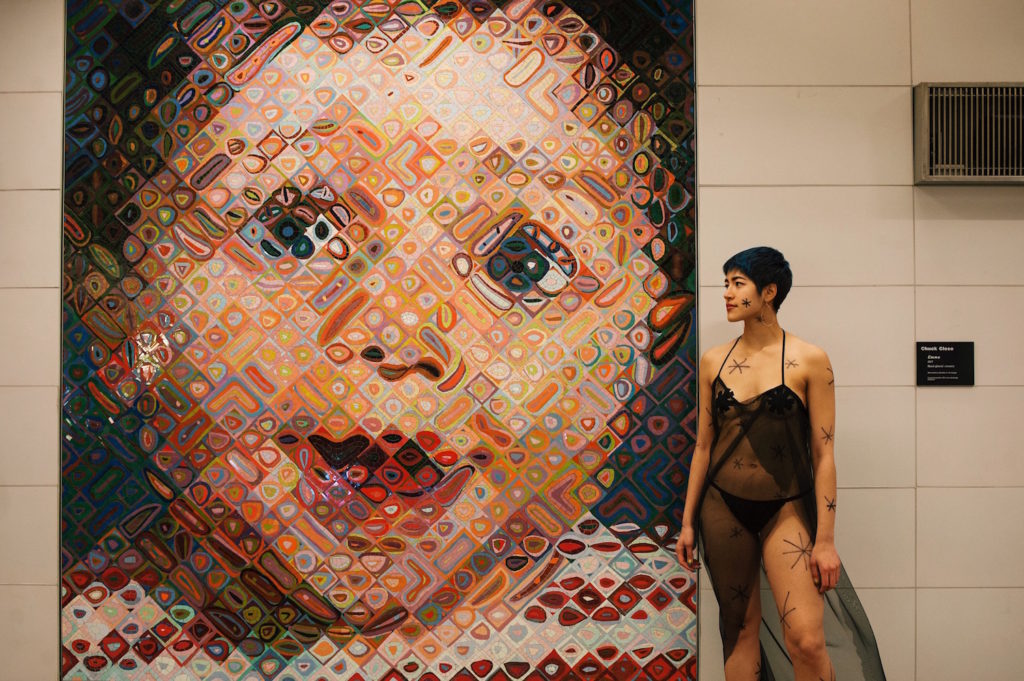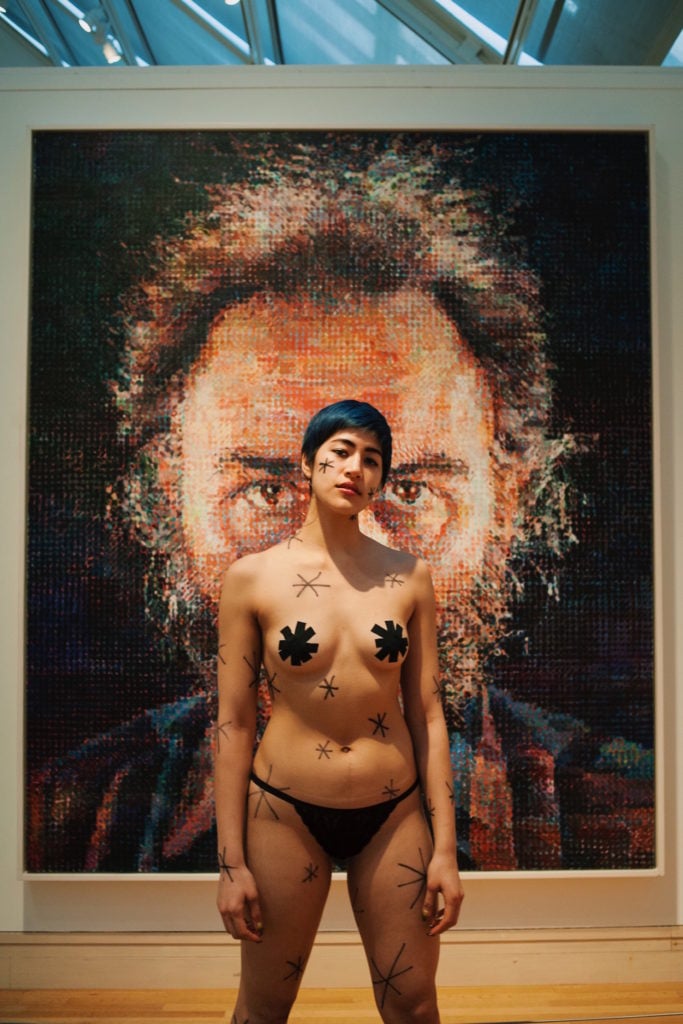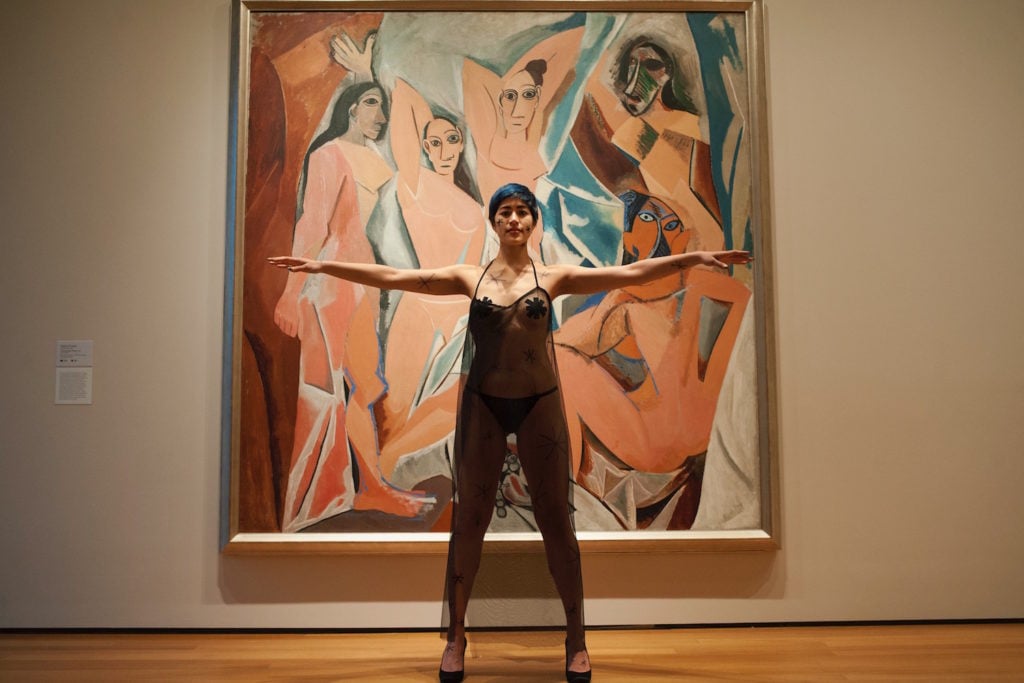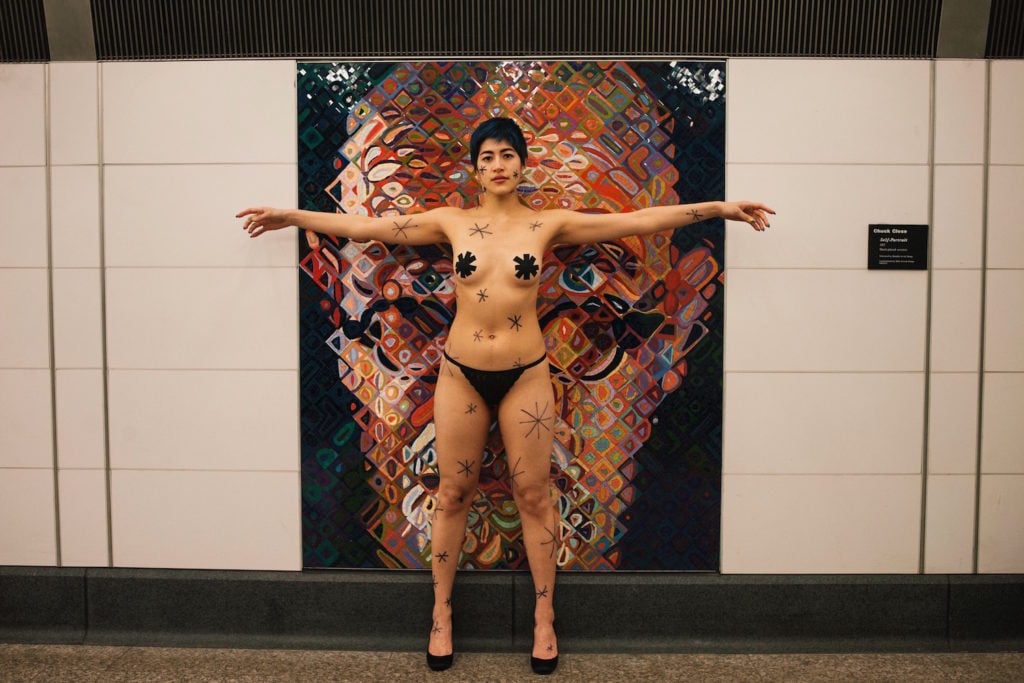Politics
Artist Emma Sulkowicz Wore Asterisks—and Little Else—to Protest Chuck Close at the Met (and Picasso at MoMA)
The provocative action had an important message.

The provocative action had an important message.

Sarah Cascone

Emma Sulkowicz, an artist best known for lugging a mattress around Columbia University in protest of the school’s handling of rape allegations, is making headlines again. On Tuesday, Sulkowicz, accompanied by photographer Sangsuk Sylvia Kang, staged a series of performative protests in New York at the Metropolitan Museum of Art, the Museum of Modern Art, and a Second Avenue subway station.
The performance’s main target, the New York Times reported, was the work of Chuck Close, who was recently accused of making crude comments to his female models. Clad in a pair of black underwear and asterisk-shaped pasties, Sulkowicz stood in front of Close’s work at the Met and at the 86th Street Q station, which features mosaics by the artist, including a colorful self-portrait.
Sulkowicz also hit the MoMA, pausing at Pablo Picasso’s celebrated painting Les Demoiselles d’Avignon. “Picasso’s main conceit are these lines that chop up women’s body,” Sulkowicz told artnet News. “It’s kind of dismembering bodies to rearrange them as more visually appealing.”

Emma Sulkowicz’s protest performance alongside a Chuck Close painting at the Metropolitan Museum of Art. Photo courtesy of Sangsuk Sylvia Kang.
A few days before Tuesday’s action, a story in the Times had explored the possibility that museums might soon offer disclaimers about the objectionable behaviors of artists alongside their work. Such contextualizing notes, marked with asterisks, sometimes appear with controversial portrait sitters, but to add them for artists would be entering new territory.
“I was just so appalled by what the museum directors were saying in the article,” Sulkowicz said. “One guy said something like, ‘if we go down this road, all of our museum walls would be bare.’ I was like, ‘are you only showing work by Harvey Weinstein?'”
“An asterisk is such a small punctuation mark compared to the magnitude of how sexual abuse affects these women,” Sulkowicz said. “That museum directors weren’t even interested in speaking about it on those terms was really abhorrent to me.”
Stripping down in New York city was an uncomfortable experience for Sulkowicz, but “I wanted to show that the asterisk is actually an embodied experience,” Sulkowicz said, citing inspirational guerrilla performances by Andrea Fraser, who mimed sex with a pillar at the Guggenheim Bilbao in Little Frank and His Carp, and Deborah de Robertis, who exposed her vagina while sitting in front of Gustave Courbet‘s explicit L’Origine du monde (Origin of the World) painting.

Emma Sulkowicz’s protest performance with Pablo Picasso’s Les Demoiselles d’Avignon at the Museum of Modern Art. Photo courtesy of Sangsuk Sylvia Kang.
“These women had to reveal their bodies and that’s what made their performances so powerful,” Sulkowicz said.
Institutions’ responses to allegations against high-profile artists have been varied.
The National Gallery of Art in Washington, DC, decided to indefinitely postpone upcoming solo exhibitions for Close and another artist accused of sexual misconduct, Thomas Roma (who was one of Sulkowicz’s art professors at Columbia). Seattle University removed a Close work formerly on display at its library. After five women came forward with complaints about James Franco, his Palo Alto high school whitewashed a mural he had painted on campus in 2014, and he was Photoshopped out of a Vanity Fair cover shot by Annie Leibovitz.
The Pennsylvania Academy of the Fine Arts, however, has opted not to shorten the run of “Chuck Close Photographs,” which originated at the Parrish Art Museum in Water Mill, New York, and is scheduled to be on view through April 8. Instead, they are curating a new exhibition that draws from the permanent collection to illustrate ways that gender imbalance and abuses of power have played out in the art world.

Emma Sulkowicz’s protest performance, with a Chuck Close mosaic at the Second Avenue subway 86th Street station. Photo courtesy of Sangsuk Sylvia Kang.
“I am convinced that if we took the show down, we would be cleaning our hands of the situation,” museum director Brooke Davis Anderson told the Huffington Post. “I felt keeping the exhibition open would ensure we face this conversation rather than conclude that we’ve dealt with it by taking the show down. This facilitates a difficult conversation.”
Earlier in the week, Sheena Wagstaff, the Met’s chairman for modern and contemporary art, had cautioned against museums placing too much emphasis on sexual misconduct. “By taking action in the form of canceling an exhibition or removing art from the walls, a museum is creating an understanding of an artist’s work only through the prism of reprehensible behavior,” she told the Times. “If we only see abuse when looking at a work of art, then we have created a reductive situation in which art is stripped of its intrinsic worth—and which in turn provokes the fundamental question of what the museum’s role in the world should be.”
Sulkowicz’s protest caught the attention of security at the Met, but the artist left before a supervisor arrived on the scene. MoMA issued a statement noting that “we respect the rights of individuals to speak out on issues they feel strongly about, and recognize that museums are important centers of debate and conversation.” Neither the Met nor representatives of MTA Arts & Design responded to artnet News’s request for comment.
Emma Sulkowicz’s first New York gallery show, “The Floating World by Emma Sulkowicz,” will be on view at the Invisible Dog Art Center, 51 Bergen Street, Brooklyn, March 10–April 22, 2018.